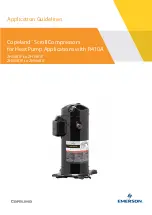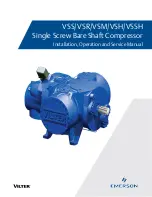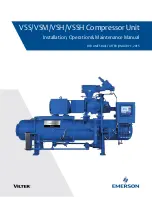
HPS Rotary Screw Compressor Units
070.700-IOM (MAR 21)
Page 24
Operation
Low ambient operation
It is best practice to insulate oil separators as a minimum
requirement to preserve the heat generated by the oil
heaters. It is important to insulate the coalescer end of the
separator to prevent refrigerant condensation.
It is important to control separator temperature to avoid
liquid condensation in the separator during standby. Do
this through a combination of reducing the standby pres
-
sure in the oil separator and insulatng the separator to
maintain temperature above saturation temperature during
standby.
On systems located outdoors or in unheated buildings
where the ambient temperature could drop below +40°F
(+4.4°C), insulate and/or heat trace the compressor lube
oil systems.
When low ambient temperatures (below +20°F [-6.7°C])
are a possibility, it is best practice to heat trace and insu-
late lube oil lines, oil filters, oil pumps, and oil coolers.
Freeze-up protection must also be provided for all water-
cooled equipment
Initial start-up
You must perform the initial start-up under the super vision
of a Johnson Controls-Frick authorized start-up represen-
tative, to prevent voiding the compressor warranty. Before
start-up, perform the prestart check. See
in the Forms section.
Initial start-up procedure
After successfully completing the
prestart check list, the
compressor unit is ready for start-up. It is impor tant that
an adequate refrigerant load is available to load test the
unit at normal operating conditions. Keep the following
points in mind during initial start-up:
1.
It is imperative that during the initial start‑up of the
package, the
hand expansion valve on the main oil
injection line is fully open to ensure adequate oil flow.
There is still an orifice installed in the compressor to
con
trol maximum oil flow. At initial start-up of the
package the hand expansion valve must be fully open.
After initial start-up of the package, adjust the hand
expansion valve. There are two methods of determin-
ing the correct adjustment of this valve.
The best method to determine target discharge
temperature is to run
CoolWare™ with the operating
conditions of the compressor. The program produces a
theoretical discharge temperature of the compressor.
After determining this temperature, you can adjust the
hand expansion valve accordingly. The ideal discharge
temperature is within 5°F (2.8°C) + or – of the theoreti-
cal discharge temperature. Adjust the valve to achieve
the theoretical discharge temperature. If you do not
have access to CoolWare™, 160°F (71.1°C) is a good
target discharge temperature for a cascade CO
2
com-
pressor. Ammonia heat pump applications run hotter.
a.
The first method is used for compressors with
ex-
ternal oil cooling (thermosyphon, water cooled, and
glycol cooled). Before the initial startup of the com
-
pressor close the hand expansion valve completely.
Open the valve back up and count the turns that it
takes to fully open the valve. After the initial startup
close the valve to achieve approximately 160°F
(71.1°C) discharge temperature or the theoretical
temperature from CoolWare. Do not fully close the
valve at any time while the compressor is running.
b. The second method is used for compressors with
liquid injection oil cooling. Because the discharge
temperature is controlled by the liquid injection
thermal expansion valve adjustment for the correct
oil flow by using the discharge temperature is not
possible. Before the initial startup of the compressor,
close the main oil injection hand expansion valve
completely. Open the valve back up and count the
turns that it takes to fully open the valve. After the
initial startup, close the valve until it is two turns
open. The valve may need to be closed further to
reduce excessive noise and vibration. However, DO
NOT fully close the valve.
Warning
Failure to correctly adjust this valve can lead to
excessive noise and vibration of the compressor and
package, premature failure of the bearings, liquid
slugging of the compressor, oil starvation of the ro-
tors, and catastrophic failure of the compressor.
2. For correct and safe operation, you must run the com-
pressor at the correct speed and discharge pressure.
Exceeding design conditions creates a potential hazard.
3.
Rotate and lubricate motor bearings according to
manufacturer’s recommendations
before
initial start-up
as required.
4.
After running the unit for approximately 3 hours, adjust
the liquid injection oil cooling if applicable. If the unit
has water-cooled oil cooling, adjust the
water control
valve to the cooler.
5. Perform a vibration analysis if equipment is available.
6. For VFD applications, you must identify and enter skip
frequencies.
















































